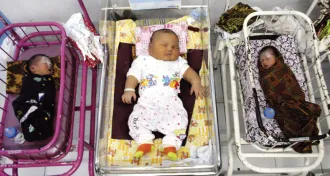Humans
Sign up for our newsletter
We summarize the week's scientific breakthroughs every Thursday.
-
 Health & Medicine
Health & MedicineFeedback
Readers question pertussis vaccination scheduling, share stories about earthquakes and more.
-
 Humans
HumansBig babies: High birthweight may signal later health risks
A high birthweight might signal health risks later in life.
By Nathan Seppa -
 Genetics
GeneticsQatari people carry genetic trace of early migrants out of Africa
Qatari genomes carry shards of DNA that date back 60,000 years, when humans began to leave Africa.
-
 Anthropology
AnthropologyTeen’s skeleton ties New World settlers to Native Americans
Underwater cave discovery in Mexico shows genetic range of New World’s ancient Asian colonists.
By Bruce Bower -
 Health & Medicine
Health & MedicineBlood test predicts if false labor is headed for delivery room
A test for white blood cells and specific genetic markers may offer insights into whether preterm contractions are false labor or the real thing.
By Nathan Seppa -
 Health & Medicine
Health & MedicineHealth care workers test negative for MERS virus
Two health care workers who reportedly fell ill with flulike symptoms after coming in contact with a patient suffering from MERS have tested negative for the virus, according to health officials.
-
 Health & Medicine
Health & MedicineSmall molecule aids recovery from radiation sickness
A drug for radiation sickness is a small step toward the larger goal of making effective treatments for human radiation exposure, whether as a medical treatment or after a nuclear disaster.
-
 Health & Medicine
Health & MedicineTwo U.S. health care workers fall ill after treating patient with MERS
Two Florida hospital employees have reportedly fallen ill with flulike symptoms after coming in contact with a patient suffering from MERS.
-
 Health & Medicine
Health & MedicineRed wine’s resveratrol not linked to healthier life
Consuming the compound resveratrol in foods is thought to improve health, but it may not actually have anti-inflammatory or anticancer effects.
-
 Health & Medicine
Health & MedicineSecond MERS case in U.S. confirmed
A second health care worker has been diagnosed with MERS coronavirus in the United States.
-
 Psychology
PsychologyFarming practices have shaped thinking styles
The different levels of cooperation required to grow rice and wheat have sown psychological differences within China and possibly between East Asia and the West.
By Bruce Bower -
 Health & Medicine
Health & MedicinePoor ventilation in schools may spur TB spread
Researchers found high carbon dioxide levels in South African classrooms, suggesting that poor ventilation may contribute to tuberculosis transmission.
By Nathan Seppa